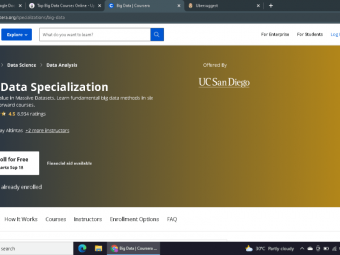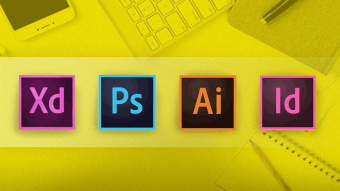Altera Fpgas Learning Through Labs Using Vhdl
Tags: FPGA
Grab your Altera FPGA development board and get a hands on approach to learning all about your FPGA through labs
Last updated 2022-01-10 | 3.5
- Understand the design process for implementing a digital design onto a FPGA- Program a FPGA
- Replicate all the labs demonstrated in this lab
What you'll learn
* Requirements
* Purchase an Altera FPGA Development Board* we cover supported boards in the course
* Basic understanding of binary notation
* Basic understanding of hexadecimal notation
* Basic understanding of logic gates
* Basic understanding of VHDL
Description
Altera FPGAs: Learning Through Labs with VHDL teaches students digital design using the hands on approach. This course focuses on the actual VHDL implementation compared to the theory. The best most efficient way to learn VHDL is by actually writing and creating designs yourself. This courses includes 9 labs which include design for the following:
- BCD Display
- Random Number Generator
- Signed Multiplier
- Barrel Shifter
- Arithmetic Logic Unit
- Temperature Sensor
- Tilt Sensor
- Microphone Interface
- Potentiometer Interface
This course is structured such that each section contains a specific topic that is briefly discussed and then you will be given a design to start with to complete the lab. All the completed code solutions for each project will be available for download as a resource. Each section will contain a setup lecture that explains how to setup the lab. There is also a demonstration video given as a reference for a working design.
Who this course is for:
- Engineering Students
- Engineering Managers
- Digital Logic Enthusists
- Individuals pursuing Electrical Engineering
- Anyone who wants to learn more about VHDL
- Anyone who wants to take it for fun!
Course content
12 sections • 60 lectures
Introduction Preview 01:56
In this lecture, I will introduce myself and explain what is covered in this course. I also will explain what you can expect to get out of the course.
Where should you buy your FPGA board? Preview 00:12
This lecture provides students with links to websites were they can buy FPGA development boards.
Lab Materials Preview 00:00
FPGA Board's Covered in this Course Preview 00:22
This lecture talks about all the FPGA development boards covered in this course.
Which FPGA Board Are You Using? Preview 00:16
This lecture provides a link to a survey which will help me better understand which development boards everybody is using.
Course Structure Preview 00:27
This lecture lays out the structure of this course and explains all the content that will be covered.
BCD Display Explained Preview 06:45
This lecture explains what a BCD display is and ways that they can be used. We will be implementing this design in the lab.
BCD Display Assignment Preview 00:50
This lecture explains whats the student needs to do in order to complete the assignment. This lecture also contains recommended steps to complete the assignment. This lecture contains designs the students may download for reference.
BCD Display Lab Setup Preview 02:04
This lecture walks through to show you how to setup the BCD Display lab.
DE0 Nano SOC Board - BCD Display Demonstration Preview 03:21
Linear Feedback Shift Register Explained Preview 05:31
This lecture explains Linear Feedback Shift Registers (LFSR). LFSR’s can be used for various applications, in this lab we will be using the LFSR to generate pseudo random numbers.
Linear Feedback Shift Register Assignment Preview 00:56
This lecture explains whats the student needs to do in order to complete the assignment. This lecture also contains recommended steps to complete the assignment. This lecture contains designs the students may download for reference.
Linear Feedback Shift Register Lab Setup Preview 02:04
This lecture is a demonstration of the LFSR running on the DE0-Nano-SoC board.
DE0 Nano SOC Board - LFSR Demonstration Preview 03:15
Booth's Algorithm Explained Preview 06:40
This lecture introduces booth’s algorithm and how it works. This is the algorithm that we will be implementing for this lab.
Booth's Algorithm Assignment Preview 01:17
This lecture explains whats the student needs to do in order to complete the assignment. This lecture also contains recommended steps to complete the assignment. This lecture contains designs the students may download for reference.
Booth's Algorithm Lab Setup Preview 02:57
DE0 Nano SOC Board - Booth's Algorithm Demonstration Preview 04:26
Barrel Shifter Explained Preview 06:00
This lecture explains what a barrel shifter is and how they are used in digital designs. The designed explained in this lecture will be used to complete lab 4.
Barrel Shifter Assignment Preview 00:53
This lecture explains whats the student needs to do in order to complete the assignment. This lecture also contains recommended steps to complete the assignment. This lecture contains designs the students may download for reference.
Barrel Shifter Lab Setup Preview 02:21
This lecture walks through to show you how to setup the Barrel Shifter lab.
DE0 Nano SOC Board - Barrel Shifter Demonstration Preview 06:15
Barrel Shifter Quiz
ALU (Arithmetic Logic Unit) Explained Preview 07:14
This lecture describes what ALU’s are and how they relate to digital designs. We will be implementing an ALU in VHDL for this lab assignment.
Arithmetic Logic Unit Assignment Preview 01:04
This lecture explains whats the student needs to do in order to complete the assignment. This lecture also contains recommended steps to complete the assignment. This lecture contains designs the students may download for reference.
ALU Lab Setup Preview 02:57
DE0 Nano SOC Board - ALU Demonstration Preview 06:52
Temperature Sensor Interface Explained Preview 05:11
This lecture explains how the temperature sensor used in this lab works. I will explain how to read the data and how to convert the values to an actual temperature reading.
Temperature Sensor Assignment Preview 00:48
This lecture explains whats the student needs to do in order to complete the assignment. This lecture also contains recommended steps to complete the assignment. This lecture contains designs the students may download for reference.
Temperature Sensor Lab Setup Preview 03:09
DE0 Nano SOC Board - Temperature Sensor Demonstration Preview 02:43
Tilt Sensor Interface Explained Preview 01:50
This lecture explains how a tilt sensor works and various applications they can be used in. This lecture explains how we will be using the tilt sensor in this lab.
Tilt Sensor Assignment Preview 00:40
This lecture explains whats the student needs to do in order to complete the assignment. This lecture also contains recommended steps to complete the assignment. This lecture contains designs the students may download for reference.
Tilt Sensor Lab Setup Preview 02:50
DE0 Nano SOC Board - Tilt Sensor Demonstration Preview 02:32
Microphone Interface Explained Preview 04:44
This lecture discusses how you can interface a microphone with an FPGA. In this lab, we will be interfacing the FPGA with a microphone.
Microphone Interface Assignment Preview 00:54
This lecture explains whats the student needs to do in order to complete the assignment. This lecture also contains recommended steps to complete the assignment. This lecture contains designs the students may download for reference.
Microphone Interface Lab Setup Preview 01:53
DE0 Nano SOC Board - Microphone Demonstration Preview 02:40
Microphone Interface Quiz
Potentiometer Interface Explained Preview 03:01
This lecture talks about how a potentiometer can be interfaced with an FPGA. We will be interfacing the FPGA with a potentiometer for this lab.
Potentiometer Interface Assignment Preview 01:00
This lecture explains whats the student needs to do in order to complete the assignment. This lecture also contains recommended steps to complete the assignment. This lecture contains designs the students may download for reference.
Potentiometer Interface Lab Setup Preview 02:42
This lecture walks through to show you how to setup the Potentiometer Interface lab.
DE0 Nano SOC Board - Potentiometer Demonstration Preview 02:42
ALU (Arithmetic Logic Unit) Explained Notes Preview 00:01
Barrel Shifter Explained Notes Preview 00:00
BCD Display Explained Notes Preview 00:00
Booth's Algorithm Explained Notes Preview 00:00
LCD Design Interface Explained Notes Preview 00:01
Linear Feedback Shift Register Explained Notes Preview 00:01
Microphone Interface Explained Notes Preview 00:00
Potentiometer Interface Explained Notes Preview 00:00
Temperature Sensor Interface Explained Notes Preview 00:01
Tilt Sensor Interface Explained Notes Preview 00:01
8-Bit ALU in VHDL Example Preview 00:41
16-Bit ALU in VHDL Example Preview 00:57
Display Decoder Example Preview 00:09
Booth's Algorithm Example and Link Preview 00:02
LCD 90s vs Today Example Preview 00:08
Conclusion Preview 00:33
This lecture concludes the completion of the course.








 This course includes:
This course includes:



![The Complete Dart Learning Guide [2022 Edition]](https://img-c.udemycdn.com/course/100x100/4284484_427a_5.jpg)











